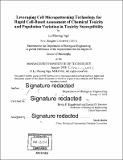| dc.contributor.advisor | Bevin P. Engelward and Leona D. Samson. | en_US |
| dc.contributor.author | Ngo, Le Phuong | en_US |
| dc.contributor.other | Massachusetts Institute of Technology. Department of Biological Engineering. | en_US |
| dc.date.accessioned | 2018-05-23T16:33:19Z | |
| dc.date.available | 2018-05-23T16:33:19Z | |
| dc.date.copyright | 2018 | en_US |
| dc.date.issued | 2018 | en_US |
| dc.identifier.uri | http://hdl.handle.net/1721.1/115754 | |
| dc.description | Thesis: Ph. D., Massachusetts Institute of Technology, Department of Biological Engineering, 2018. | en_US |
| dc.description | Cataloged from PDF version of thesis. | en_US |
| dc.description | Includes bibliographical references. | en_US |
| dc.description.abstract | With the advent of combinatorial chemistry, the number of novel synthetic chemicals has skyrocketed over the past three decades, bringing about tremendous advances in medicine and material science. At the same time, the massive libraries of existing chemicals coupled with the unprecedented rate of new chemical generation presents a unique and costly challenge to toxicity testing in the 21 st century. In recent years, the United States has seen large coordinated efforts across governmental agencies to shift from expensive and slow traditional in vivo tests to more affordable and higher throughput in vitro methods. For each human cell, about 100,000 DNA lesions occur every day. Unrepaired DNA damage can lead to deleterious health consequences, including cancer and aging. Therefore, an essential endpoint in cell-based chemical safety testing is the assessment of a compound's genotoxic potential. In this work, we developed a CometChip platform that addresses two major areas that are lacking in genotoxicity testing: 1. rapid and sensitive detection of bulky DNA adducts, and 2. robust and physiologically relevant metabolism of test compounds. The assay uses two DNA repair synthesis inhibitors, hydroxyurea and I-[beta]-D-arabinofuranosyl cytosine, to cause strand-break accumulation and HepaRGTM cells to provide high levels of liver-specific functions. We also conducted extensive validation studies and a small chemical screen to demonstrate the platform's applicability in genotoxicity testing. One of the most important decisions of proliferating cells under stresses is to divide, senesce, or die. Therefore, in vitro measurements of cell survival after a toxic exposure are among the most fundamental and broadly used endpoints in biology. The gold standard for cell survival testing is the colony forming assay, which is exquisitely sensitive but sees limited uses due its low-throughput nature and requirement of large dishes. We have developed MicroColonyChip as a high-throughput platform that can directly measure a cell's ability to divide and has the potential to provide highly sensitive and rapid toxicity assessment of chemicals of interest. The technology is based on the use of a microcolony array where the size distributions for different conditions provide a direct measure of cell survival. We have results showing that MicroColonyChip is as sensitive as the gold standard assay, reduces ~80% incubation time, and requires ~250x less surface area for cell growth. In addition to detecting genotoxic agents, it is also important to understand how an individual responds to internal and external assaults to DNA as a necessary first step for assessment of human health outcomes. There is a high variability in DNA repair capacity among people, and more studies are needed to elucidate whether a causal relationship between DNA repair capacity and clinical outcomes exists. We applied CometChip to study repair kinetics in human primary lymphocytes. In order to account for the extensive crosstalk and competition between different repair pathways, repair of different types of DNA damage was measured. To test the assay's sensitivity and reproducibility, a small population of 56 healthy volunteers were recruited to give blood samples. Isolated lymphocytes from different individuals show significant differences in repair kinetics of oxidative damage and a sevenfold variation in repair rates. Taken together, the work described here represents significant technological advances in addressing a number of major challenges in chemical toxicity testing as well as in the evaluation of health outcome variability across populations. The technologies also open doors to exciting opportunities in personalized strategies for disease prevention and intervention. | en_US |
| dc.description.statementofresponsibility | by Le Phuong Ngo. | en_US |
| dc.format.extent | 194 pages | en_US |
| dc.language.iso | eng | en_US |
| dc.publisher | Massachusetts Institute of Technology | en_US |
| dc.rights | MIT theses are protected by copyright. They may be viewed, downloaded, or printed from this source but further reproduction or distribution in any format is prohibited without written permission. | en_US |
| dc.rights.uri | http://dspace.mit.edu/handle/1721.1/7582 | en_US |
| dc.subject | Biological Engineering. | en_US |
| dc.title | Leveraging cell micropatterning technology for rapid cell-based assessment of chemical toxicity and population variation in toxicity susceptibility | en_US |
| dc.type | Thesis | en_US |
| dc.description.degree | Ph. D. | en_US |
| dc.contributor.department | Massachusetts Institute of Technology. Department of Biological Engineering | |
| dc.identifier.oclc | 1036987079 | en_US |
